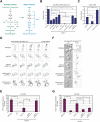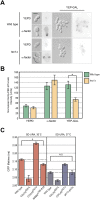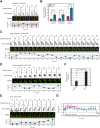Regulation of intrinsic polarity establishment by a differentiation-type MAPK pathway in S. cerevisiae
- PMID: 32079658
- PMCID: PMC7174846
- DOI: 10.1242/jcs.241513
Regulation of intrinsic polarity establishment by a differentiation-type MAPK pathway in S. cerevisiae
Abstract
All cells establish and maintain an axis of polarity that is critical for cell shape and progression through the cell cycle. A well-studied example of polarity establishment is bud emergence in the yeast Saccharomyces cerevisiae, which is controlled by the Rho GTPase Cdc42p. The prevailing view of bud emergence does not account for regulation by extrinsic cues. Here, we show that the filamentous growth mitogen activated protein kinase (fMAPK) pathway regulates bud emergence under nutrient-limiting conditions. The fMAPK pathway regulated the expression of polarity targets including the gene encoding a direct effector of Cdc42p, Gic2p. The fMAPK pathway also stimulated GTP-Cdc42p levels, which is a critical determinant of polarity establishment. The fMAPK pathway activity was spatially restricted to bud sites and active during the period of the cell cycle leading up to bud emergence. Time-lapse fluorescence microscopy showed that the fMAPK pathway stimulated the rate of bud emergence during filamentous growth. Unregulated activation of the fMAPK pathway induced multiple rounds of symmetry breaking inside the growing bud. Collectively, our findings identify a new regulatory aspect of bud emergence that sensitizes this essential cellular process to external cues.
Keywords: Bud emergence; Cdc42p; MAPK; Polarity establishment; Pseudohyphal growth; Symmetry breaking.
© 2020. Published by The Company of Biologists Ltd.
Conflict of interest statement
Competing interestsThe authors declare no competing or financial interests.
Figures






Similar articles
-
Regulation of Cdc42 protein turnover modulates the filamentous growth MAPK pathway.J Cell Biol. 2022 Dec 5;221(12):e202112100. doi: 10.1083/jcb.202112100. Epub 2022 Nov 9. J Cell Biol. 2022. PMID: 36350310 Free PMC article.
-
Functions for Cdc42p BEM adaptors in regulating a differentiation-type MAP kinase pathway.Mol Biol Cell. 2020 Mar 15;31(6):491-510. doi: 10.1091/mbc.E19-08-0441. Epub 2020 Jan 15. Mol Biol Cell. 2020. PMID: 31940256 Free PMC article.
-
Spatial landmarks regulate a Cdc42-dependent MAPK pathway to control differentiation and the response to positional compromise.Proc Natl Acad Sci U S A. 2016 Apr 5;113(14):E2019-28. doi: 10.1073/pnas.1522679113. Epub 2016 Mar 21. Proc Natl Acad Sci U S A. 2016. PMID: 27001830 Free PMC article.
-
Cdc42: An essential Rho-type GTPase controlling eukaryotic cell polarity.Microbiol Mol Biol Rev. 1999 Mar;63(1):54-105. doi: 10.1128/MMBR.63.1.54-105.1999. Microbiol Mol Biol Rev. 1999. PMID: 10066831 Free PMC article. Review.
-
Symmetry breaking in the life cycle of the budding yeast.Cold Spring Harb Perspect Biol. 2009 Sep;1(3):a003384. doi: 10.1101/cshperspect.a003384. Cold Spring Harb Perspect Biol. 2009. PMID: 20066112 Free PMC article. Review.
Cited by
-
Modulators of MAPK pathway activity during filamentous growth in Saccharomyces cerevisiae.G3 (Bethesda). 2024 Jun 5;14(6):jkae072. doi: 10.1093/g3journal/jkae072. G3 (Bethesda). 2024. PMID: 38560781 Free PMC article.
-
Regulation of Cdc42 protein turnover modulates the filamentous growth MAPK pathway.J Cell Biol. 2022 Dec 5;221(12):e202112100. doi: 10.1083/jcb.202112100. Epub 2022 Nov 9. J Cell Biol. 2022. PMID: 36350310 Free PMC article.
-
A Rab escort protein regulates the MAPK pathway that controls filamentous growth in yeast.Sci Rep. 2020 Dec 17;10(1):22184. doi: 10.1038/s41598-020-78470-4. Sci Rep. 2020. PMID: 33335117 Free PMC article.
-
Spatiotemporal control of pathway sensors and cross-pathway feedback regulate a differentiation MAPK pathway in yeast.J Cell Sci. 2021 Aug 1;134(15):jcs258341. doi: 10.1242/jcs.258341. Epub 2021 Aug 4. J Cell Sci. 2021. PMID: 34347092 Free PMC article.
-
Cullin-Conciliated Regulation of Plant Immune Responses: Implications for Sustainable Crop Protection.Plants (Basel). 2024 Oct 26;13(21):2997. doi: 10.3390/plants13212997. Plants (Basel). 2024. PMID: 39519916 Free PMC article. Review.
References
-
- Adhikari H., Vadaie N., Chow J., Caccamise L. M., Chavel C. A., Li B., Bowitch A., Stefan C. J. and Cullen P. J. (2015). Role of the unfolded protein response in regulating the mucin-dependent filamentous-growth mitogen-activated protein kinase pathway. Mol. Cell. Biol. 35, 1414-1432. 10.1128/MCB.01501-14 - DOI - PMC - PubMed
Publication types
MeSH terms
Substances
Grants and funding
LinkOut - more resources
Full Text Sources
Molecular Biology Databases

